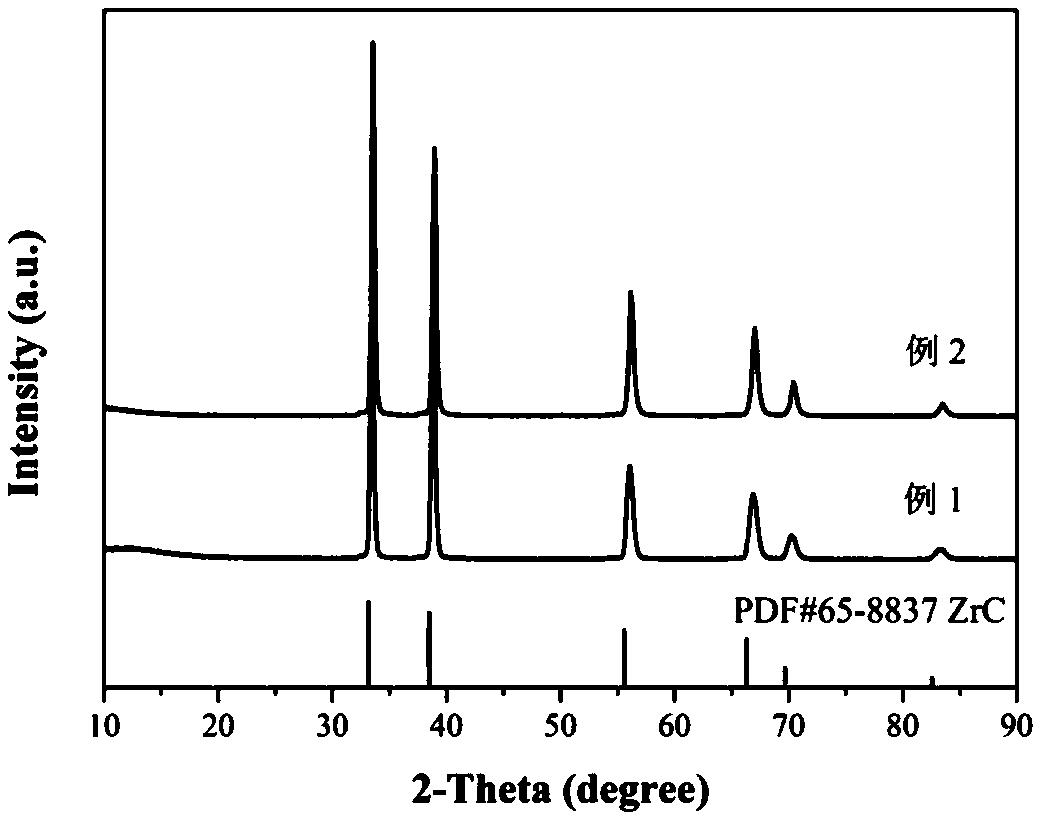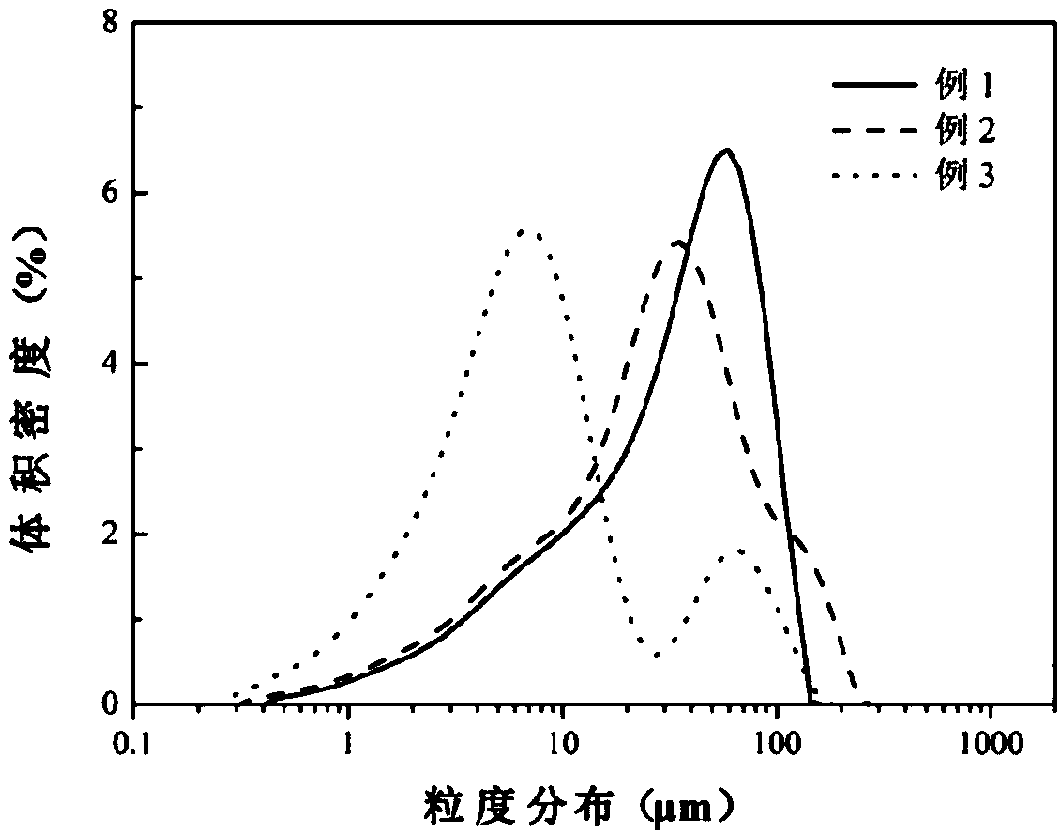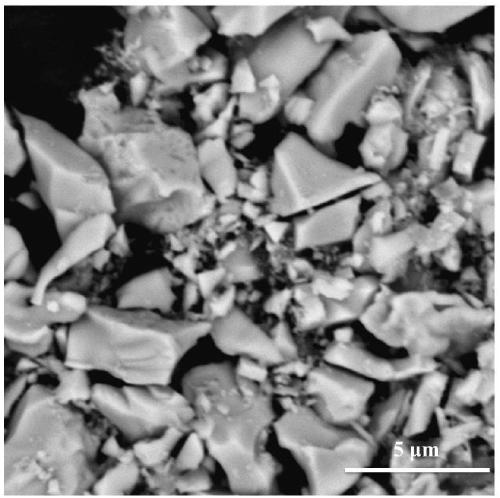High-entropy carbide ultrahigh temperature ceramic powder and preparation method thereof
A technology for ultra-high temperature ceramics and ceramic powders, applied in the field of carbide ceramics, can solve the problems of low purity of carbide ceramic powders, long sol-gel reaction period, high mixing uniformity requirements, etc. control, short preparation time and high antioxidant properties
- Summary
- Abstract
- Description
- Claims
- Application Information
AI Technical Summary
Problems solved by technology
Method used
Image
Examples
Embodiment 1
[0034] The Zr powder, Ti powder, and C powder are ball milled on a planetary ball mill for 2 hours according to the molar ratio of 0.8:0.2:0.9, wherein the particle size of the Zr powder and Ti powder is -300 mesh, and the C powder is -4000 mesh, with a purity of ≥99%. The ball milling medium is ethanol, the rotation speed is 100rpm, the ball-to-material ratio is 5:1, after ball milling, it is taken out and dried at 40°C, and the mixed powder is obtained after sieving;
[0035] Place the mixed powder in a graphite mold for pressureless discharge plasma sintering for pressureless discharge plasma sintering. The vacuum degree in the furnace is less than 5Pa, and the temperature is raised to 1300°C for 30 minutes, and the heating rate is 100°C / min. Then cool to room temperature and take out the sintered ceramics The block is crushed and then manually ground in an agate mortar to obtain carbide ceramic powder. Such as figure 1 As shown, the carbide ceramic powder exhibits typical...
Embodiment 2
[0038] The Zr powder, Ti powder, and C powder are ball milled on a planetary ball mill for 2 hours according to the molar ratio of 0.8:0.2:0.8, wherein the particle size of the Zr powder and Ti powder is -300 mesh, and the C powder is -4000 mesh, with a purity of ≥99%. The ball milling medium is ethanol, the speed is 100rpm, and the ball-to-material ratio is 5:1. After ball milling, it is taken out and dried at 40°C, and the mixed powder is obtained after sieving;
[0039] Place the mixed powder in a graphite mold for pressureless discharge plasma sintering for pressureless discharge plasma sintering. The vacuum degree in the furnace is less than 5Pa, and the temperature is raised to 1600°C for 15min at a heating rate of 100°C / min, and then cooled to room temperature to take out the sintered ceramics The block is crushed and then manually ground in an agate mortar to obtain carbide ceramic powder. Such as Figure 1-4 As shown, the carbide ceramic powder presents a typical ZrC...
Embodiment 3
[0042] The Hf powder, Zr powder, Ti powder, and C powder are ball milled on a planetary ball mill for 0.5h according to the molar ratio of 0.5:0.3:0.2:0.8, wherein the Hf powder, Zr powder, and Ti powder have a particle size of -300 mesh, and the C powder is -4000 mesh, purity ≥ 99%, the ball milling medium is ethanol, the rotation speed is 200rpm, the ball-to-material ratio is 5:1, after the ball milling, it is taken out and dried at 40°C, and the mixed powder is obtained after sieving;
[0043] Place the mixed powder in a graphite mold for pressureless discharge plasma sintering for pressureless discharge plasma sintering. The vacuum degree in the furnace is less than 5Pa, and the temperature is raised to 1600°C for 15min at a heating rate of 100°C / min, and then cooled to room temperature to take out the sintered ceramics The block is crushed and then manually ground in an agate mortar to obtain carbide ceramic powder. Such as Figure 5-7 As shown, the carbide ceramic powde...
PUM
| Property | Measurement | Unit |
|---|---|---|
| Granularity | aaaaa | aaaaa |
Abstract
Description
Claims
Application Information
 Login to View More
Login to View More - R&D
- Intellectual Property
- Life Sciences
- Materials
- Tech Scout
- Unparalleled Data Quality
- Higher Quality Content
- 60% Fewer Hallucinations
Browse by: Latest US Patents, China's latest patents, Technical Efficacy Thesaurus, Application Domain, Technology Topic, Popular Technical Reports.
© 2025 PatSnap. All rights reserved.Legal|Privacy policy|Modern Slavery Act Transparency Statement|Sitemap|About US| Contact US: help@patsnap.com



